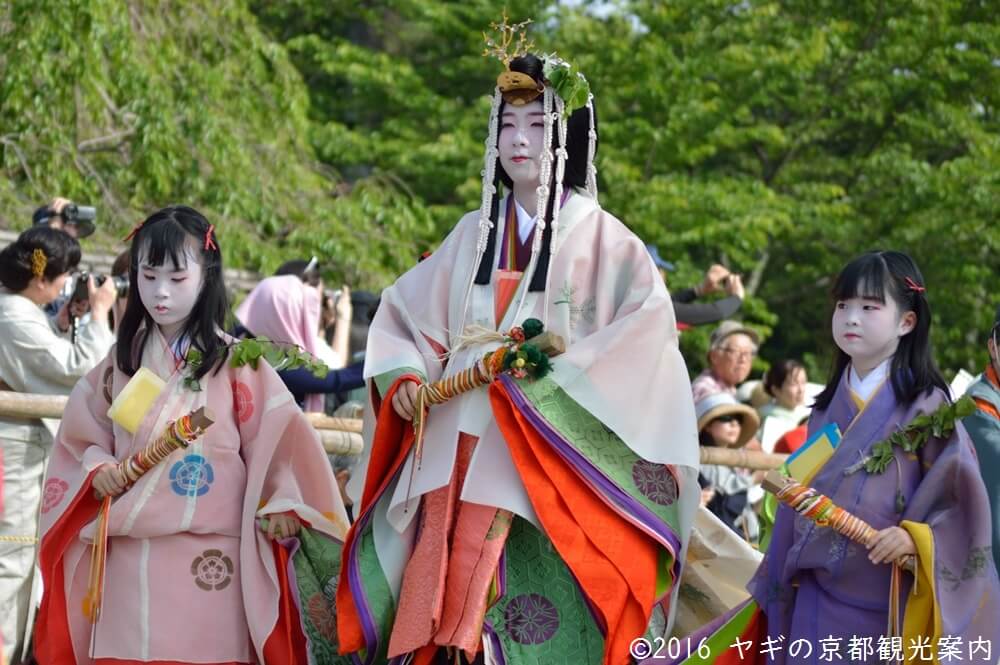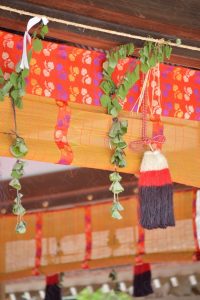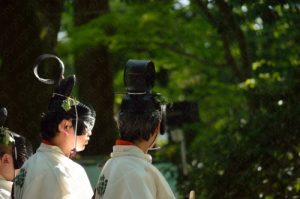THE GIST OF THIS ARTICLE
- Page 1 Schedule, What is Aoi Matsuri?
- Page 2 Saioh Dai 斎王代
- Page 3 Parade1: Chokushidai Retsu 勅使代行列
- Page 4 Parade2: Saiohdai Retsu 斎王代列
- Page 5 Shato no Gi 社頭の儀
- Page 6 Ceremonies prior to Aoi Matsuri
- Page 7 How to see the parade?
The following is the contents of this article.
What is Aoi matsuri festival?
Aoi matsuri festival is formally called “Kamo no Matsuri” because Kamo shrines hold it. The word “Kamo shrines” means Shimogamo shrine and Kamigamo shrine.
Shimogamo shrine’s formal name is “Kamo mioya jinjya shrine” and that of Kamigamo shrine is “Kamo Wake Ikazuchi jinjya shrine”. Both of them has “Kamo”, so we call both shrines “Kamo shrine” as a whole.
These shrines hold Aoi matsuri festival on the second “bird day (We put Chinese zodiac signs like bird, tiger, and other animals on the days in calendar.)” on May of ancient Japanese lunar calendar. In the present day, they hold it on 15th on May.
Aoi matsuri festival is one of “The three famous festivals in Kyoto (the others are Gion matsuri festival and Jidai matsuri festival)” and also known as one of “The three famous Chokusai in Japan”
Chokusai is a matsuri (festival) held under the order from the Imperial court. At Chokusai, the emperor sends “Chokushi”, the messenger of the Emperor to a shrine that holds Chokusai. Of course in Aoi matsuri, the emperor sends “Chokushi” to Kamo shrines.
In Heian period, “Matsuri” means nothing but Kamo no Matsuri among aristocrats. In Edo period, people called Kamo no Matsuri “Aoi matsuri” gradually because the participants of Kamo sai festival put leaves of Aoi, the crests of these shrine, on their outfits.
Reservation seat to enjoy Aoi Matsuri 2025
On 4/8
The reserved seats for individual tourists starts on 4/8, 10:00. Check the website of Kyoto Kanko Navi (in English) out.
Kyoto Imperial Palace 京都御苑
- Seats in front row: 5,500 JPY
- Seats in other rows: 4,000 JPY
- Special seats in front row: 9,500 JPY
- Special seats in other rows: 8,000 JPY Near Kenreimon gate. Souvenir available.
- Seats Royals: 20,500 JPY Audio guide in Japanese/English and souvenirs avalilable.
Shimogamo shrine 下鴨神社
- Seats in front row: 5,500 JPY
- Seats in other rows: 4,000 JPY
- Special seats in front row: 10,500 JPY
- Special seats in other rows: 9,000 JPY Audio guide in Japanese available.
- Seats Royals: 20,500 JPY
Kamigamo shrine 上賀茂神社

Reservation seats are available at Kamigamo and Shimogamo shrine.
Must sees みどころ
- Saioh dai and Parade・・・The parade brings us back to Heian period.(Page 3)
- Miare Shinji・・・Nigi Mitama and Aramitama are fused and the deity of Kamo reborn anew. (Mikage Matsuri)
- Kaeshi Norito・・・Chokushi, the messenger of Emperor, reads Norito to the deity and the deity replies. (Page 4)
Shedule 葵祭日程
Ceremonies prior to Aoi Matsuri 前儀
| 期日 | 行事名 |
| 5/1 | Ashizoroe Shiki |
| 5/3 | Yabuzame Shinji |
| 5/4 | Saihoda Gyokei no Gi |
| 5/5 | Busha Shinji |
| Kamo Kurabeuma | |
| 5/7 | Kencha Sai |
| 5/12 | Mikage Matsuri |
| Miare Shinji | |
| 5/14 | Biwako Katada Kugonin Gyoretsu Funa Hoken Sai |
The Parade 葵祭当日 5月15日
| 10:30 | Kenreimon |
| 10:50 | Sakaimach Gomon |
| 11:15 | Kawarmachi Imadegawa |
| 11:40 | Arrives Shimogamo shrine |
| Shato no Gi | |
| 14:20 | Departs Shimogamo shrine |
| 14:40 | Rakuhoku High Scholl |
| 14:55 | Kitaoji Bashi bridge |
| 15:30 | Arrives Kamigamo shrine |
Ceremonies after Aoi Matsuri 後儀
| 期日 | 行事名 |
| 5/17 | Kencha Sai at Kamigamo shrine |
| 5/21 | Kencha Sai at Shimogamo shrine |
| 5/28 | Sencha Kencha Sai at Kamigamo shrine |
The history of Aoi matsuri festival
The history of Aoi matsuri dates back to 6th century and it was called Kamo no Matsuri, a private Matusri of Kamosha. Kamosha means two shrines for the Kamo clans. Today they are known as Kamigamo and Shimogamo shrine.

Kamosha means Kamigamo and Shimogamo shrine as described before.
Kamigamo shrine mentions that the Matsuri began when Kamowake Ikazuchi no Kami, the deity enshrined in the shrine, appeared in Mt. Koyama: People welcomed him with the horses ornamented with Aoi as indicated in an oracle.
On the other hand, Shoku Nihongi (『続日本記』) and put it:
In the era of emperor Kinnmei, there were many natural disasters and droughts. The emperor asked a fortune-teller named Urabe no Ikiwakahiko about the cause. (Japanese emperor is a ruler of the country and also the highest ranked priest in Shinto, the religion which has gratitude for the nature that gives us harvest. So, if anything wrong about the nature occurred, he is responsible for it.) The fortune-teller told him the cause of the natural disasters and droughts. It was a curse of Kami (Shinto deity) of Kamo. The emperor asked him to hold a ritual to ease the Kami of Kamo. This is the begging of Aoi matsuri festival as Kamo no Matsuri.

It is not “curse” exactly. In this case, “deities curse the country” means that rituals don’t take place and the country doesn’t work as expected.
The emperor asked Ikiwakahiko to hold ritual and performed a horse racing in the sacred place where the deity was in. The each jockeys with a boar mask rode on the horses ornamented with bells. After the race, people enjoyed the fertility.
Even today, we can enjoy this horse racing. It was inherited in Aoi Matsuri as Souma no Gi in Kamogamo shrine and Yamagake in Miareno of Kamigamo shrine (This one is not open to us.).

They devoted their energy to make the Kami entertained. This is one of the aims of Matsuri. Our ancestors found Kami behind nature and natural phenomenon and believed it behaves like them.
Check out the link below.

In early 8th century, Shoku Nihongi describes many people came to Kyoto to enjoy Kamo no Matsuri and a low asked Kokushi (a kind of a prefectural governor) to make sure the Matsuri took place properly.
In 810, a conflict happened between emperor Saga and retired-emperor Heijyo gave rise to “the two Imperial courts.” Emperor Saga asked the deities of Kamosha to solve the conflict. In the end, it settled down and he sent his daughter as a priestess to Kamo no Matsuri in order to show his gratitude. This is the beginning of Kamo Sai-in the priestess involved in Kamono Matsuri on behalf of emperor. Today, Saioh-dai, a lady plays a role of Sai-in, participate in Aoi Matsuri.
Kamo no Matsuri was considered as one of the most important matsuris (festivals) in terms of the ancient Japanese law.
On the same year, it became one of Chokusais. Chokusai is a matsuri held under the order of the Imperial court. And in 819, it was added to the four Chushis. Chushi is important Matsuri next to Senso Daijo Sai, the Matsuri held when an emperor accede the throne.
As described, Kamo no Matsuri used to be a private Matsuri. In addition to it, it was listed as Chokusai, the national Matsuri. In a nutshell, there are two kinds of Matsuri.
A private ones were Miare no Matsuris in which people welcome a new-born deities. Without them, Kamo no Matsuri didn’t take place.

Even today, this type of Matsuri is alive: Mikage Matsuri of Shimogamo shrine and Miare Shinji of Kamigamo shrine.
After these Matsuris, Kamo no Matsuri was commened:
- Sai-in Gokei: Sai-in made Misogi in the bank of Kamo river
- Rotoh no Gi: Chokushi, the emperor’s messenger, and those who involved in the Matsuri left the Imperial court for Kamosha.
- Syatoh no Gi: When they arrived at Kamosha, they offer Heihaku (a gift for deity) and horse racing.
Instead of Sai-in Gokei, Saihodai Gyokei no Gi takes place today. She makes Harae and Misoghi in Kamigamo or Shimogamo shrine.
Rotoh no Gi made a parade and Shatoh no Gi was held in Kamigamo and Shimogamo shrine individually. In the old days, people enjoyed Rotho no Gi as described in The Tale of Genji.
In 13th century, the Imperial courts and the aristocrats were losing their political power and Kamo no Matsuri was on the decline and Kamo Sai-in was abolished.
In the 15th century, Onin no ran, the largest-scale civil war in Japan, devastated Kyoto and Kamo no Matsuri ceased to exist in the 16th century. After that, it was recovered a few times only to fail. Finally, it was restored as Aoi Matsuri in 1953.
In Shinbutsu Shugo
Kamosai don’t allow the co-existence of Shinto and Buddhism (Shimbutsu Shugo). In the Sharyo ( lands belong to shrines) of Kamosya, there were no Buddhist temples except their Jingujis (Buddhist temples belong to Shrine) and the monks of them were not allowed to enter Sharyo.
In 1649, Kamo Sai and Mikage matsuri were restored and these monks made a complaint. The Imperial court and Tokugawa Shogunate asked the reason to Kamosha.
It replied, “天下之通則也.”

The sentence means “Obvious. No wonder, isn’t it?”
And it also said “due to this, Saioh uses Imikotoba.”

Imikotoba means words not to be used in a situation where something bad or evil must be avoided. Saioh was a priestess who served for deities of Kamo and had to be free from these words.
In the end, they maintained the custom.

In contrast to Gion Matsuri, it’s SO interesting. In Gion Matsuri, we cannot separate Shinto and Buddhism. The earliest Gion Matsuri is called Gion Goryoe. Gorye is a Buddhist ceremony. Gion Goryoe started for the purpose of getting rid of a cause of the epidemics and natural the disasters in 863. The cause was a curse of Gozutenno.
Ancient people thought curse of someone, including deities, brought them bad things like epidemics and natural disasters. That is an idea hiding behind Shinto (primitive one) and indigenous to Japan.
In Japan, Buddhism was imported from India in the 6th century. Since then, Shinto and Buddhism started to fuse. This phenomena is called Shibutsu-Shugo and Gion Goryoe in 863 is considered as a good example of the maturity of it.
On the other hand, Kamo Sai refused Shibutsu-Shugo. In Kamo Sai, a cause of natural disasters is a curse of the deities of Kamo. And Kamo Sai tries to get rid of the cause only in Shinto-way.
ヤギの京都観光案内/KYOTO GOAT BLOGをもっと見る
購読すると最新の投稿がメールで送信されます。





